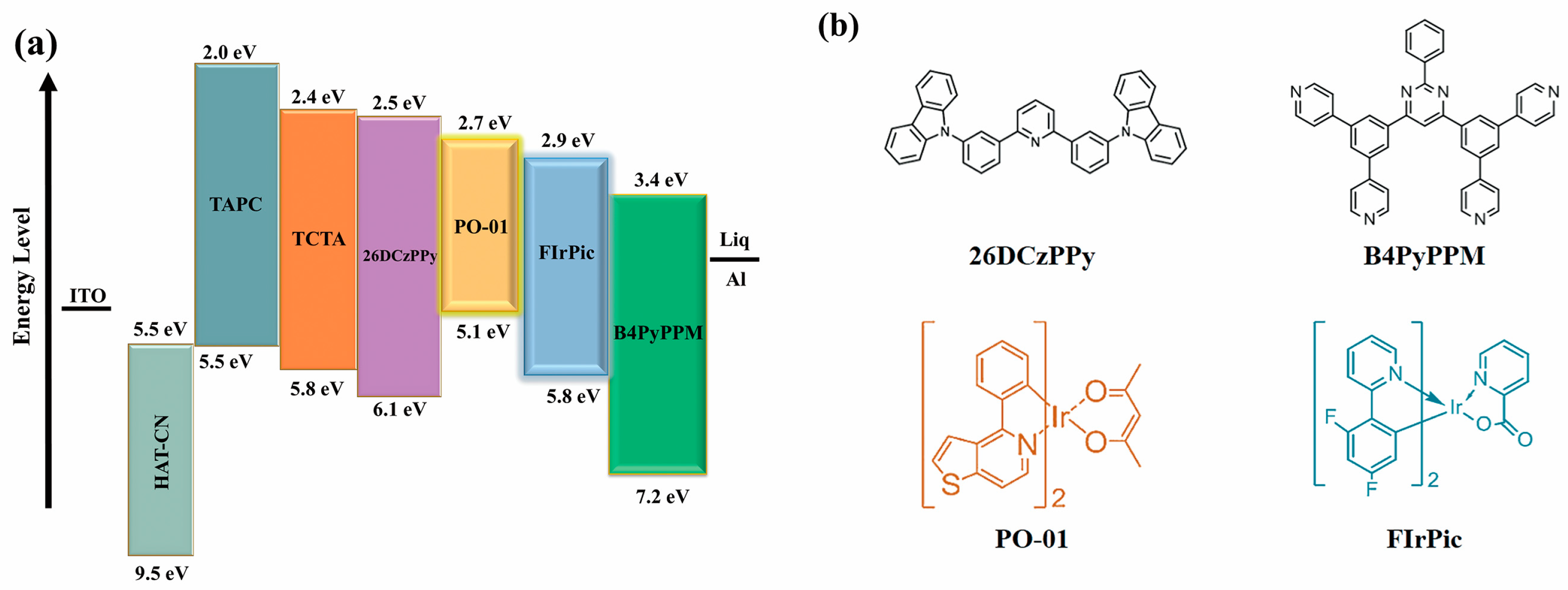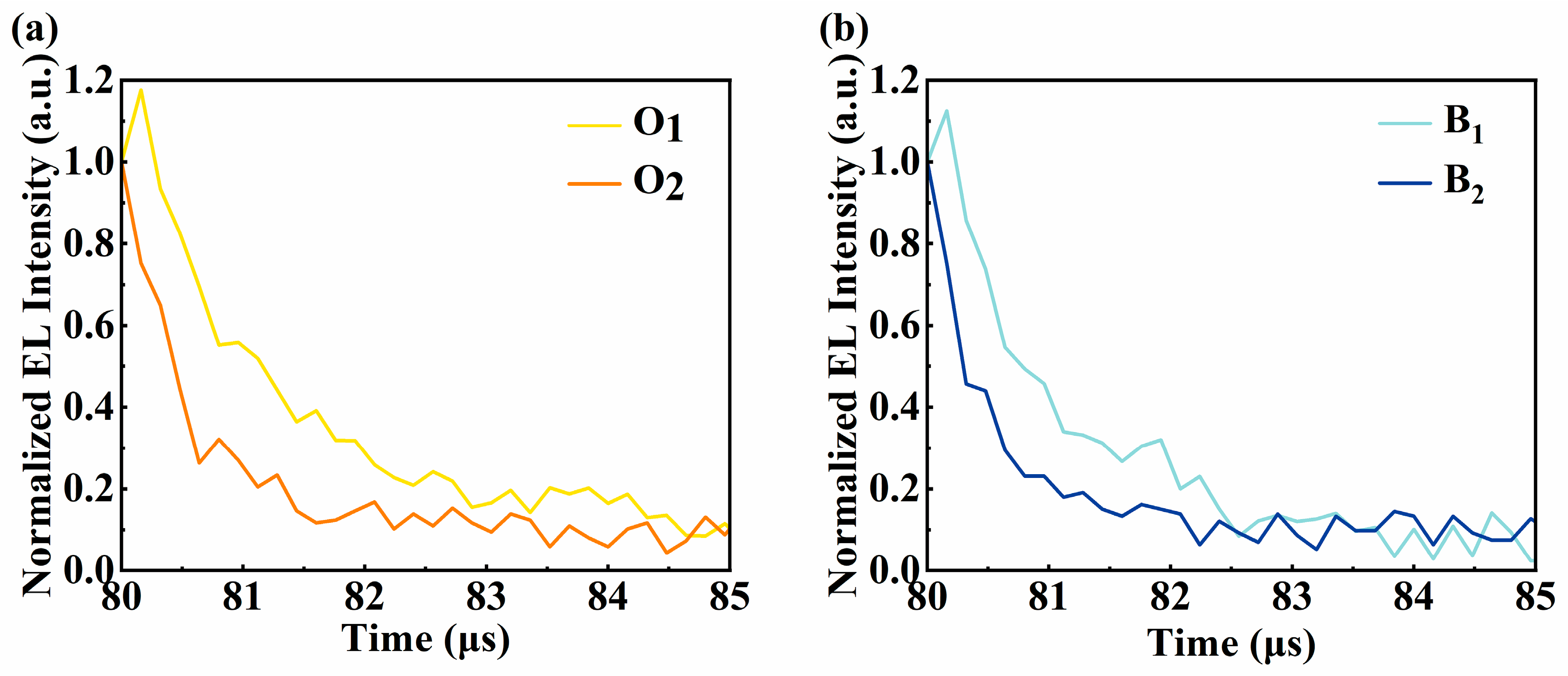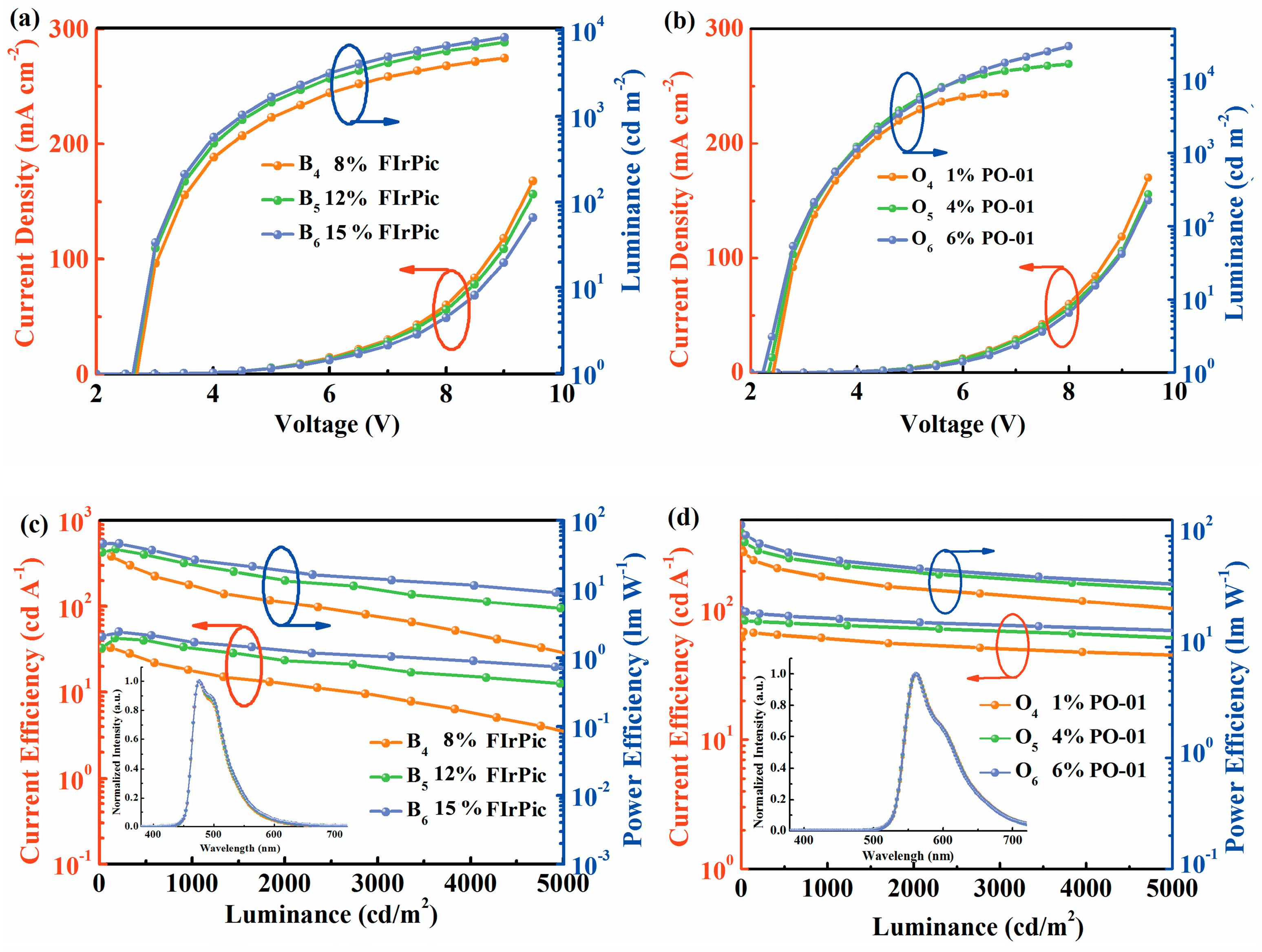Management of Exciton Distribution for High-Performance Organic Light-Emitting Diodes Based on Interfacial Exciplex Architecture
Abstract
:1. Introduction
2. Results
3. Experimental Section
4. Conclusions
Supplementary Materials
Author Contributions
Funding
Institutional Review Board Statement
Informed Consent Statement
Data Availability Statement
Conflicts of Interest
Sample Availability
References
- Lee, J.; Chen, H.F.; Batagoda, T.; Coburn, C.; Djurovich, P.I.; Thompson, M.E.; Forrest, S.R. Deep blue phosphorescent organic light-emitting diodes with very high brightness and efficiency. Nat. Mater. 2016, 15, 92–98. [Google Scholar]
- Li, H.Y.; Zhou, L.; Teng, M.Y.; Xu, Q.L.; Lin, C.; Zheng, Y.X.; Zuo, J.L.; Zhang, H.J.; You, X.Z. Highly efficient green phosphorescent OLEDs based on a novel iridium complex. J. Mater. Chem. C 2013, 1, 560–565. [Google Scholar]
- Wang, Q.; Ma, D. Management of charges and excitons for high-performance white organic light-emitting diodes. Chem. Soc. Rev. 2010, 39, 2387–2398. [Google Scholar]
- Ying, L.; Ho, C.L.; Wu, H.; Cao, Y.; Wong, W.Y. White polymer light-emitting devices for solid-state lighting: Materials, devices, and recent progress. Adv. Mater. 2014, 26, 2459–2473. [Google Scholar]
- Schwartz, G.; Pfeiffer, M.; Reineke, S.; Walzer, K.; Leo, K. Harvesting triplet excitons from fluorescent blue emitters in white organic light-emitting diodes. Adv. Mater. 2007, 19, 3672–3676. [Google Scholar]
- Fukagawa, H.; Shimizu, T.; Osada, Y.; Kamada, T.; Kiribayashi, Y.; Yamamoto, T.; Shimidzu, N. Direct Observation of Efficient Triplet–Triplet Energy Transfer in Phosphorescent Organic Light-Emitting Diode. Appl. Phys. Express 2013, 6, 052104. [Google Scholar] [CrossRef]
- Chen, P.; Sheng, R.; Ko, M.Y.; Duan, Y.; Cheng, G.; Che, C.M. Efficient white organic light-emitting diodes with double co-host emitting layers. J. Mater. Chem. C 2018, 6, 9890–9896. [Google Scholar]
- Ho, C.L.; Lin, M.F.; Wong, W.Y.; Wong, W.K.; Chen, C.H. High-efficiency and color-stable white organic light-emitting devices based on sky blue electrofluorescence and orange electrophosphorescence. Appl. Phys. Lett. 2008, 92, 083301. [Google Scholar] [CrossRef]
- Liu, X.K.; Zheng, C.J.; Lo, M.F.; Xiao, J.; Chen, Z.; Liu, C.L.; Lee, C.S.; Fung, M.K.; Zhang, X.H. Novel blue fluorophor with high triplet energy level for high performance single-emitting-layer fluorescence and phosphorescence hybrid white organic light-emitting diodes. Chem. Mater. 2013, 25, 4454–4459. [Google Scholar] [CrossRef]
- Ma, W.; Zhao, W.; Chen, C.; Zhang, E.; Tang, J.; Yan, D.; Sun, Y.; Chen, P.; Sheng, R. Highly efficient fluorescent organic electroluminescent diodes based on doping-free phosphorescent sensitization system. Org. Electron. 2023, 116, 106772. [Google Scholar] [CrossRef]
- Pan, B.; Wang, B.; Wang, Y.; Xu, P.; Wang, L.; Chen, J.; Ma, D. A simple carbazole-N-benzimidazole bipolar host material for highly efficient blue and single layer white phosphorescent organic light-emitting diodes. J. Mater. Chem. C 2014, 2, 2466–2469. [Google Scholar] [CrossRef]
- Liu, B.; Wang, L.; Gao, D.; Xu, M.; Zhu, X.; Zou, J.; Lan, L.; Ning, H.; Peng, J.; Cao, Y. Harnessing charge and exciton distribution towards extremely high performance: The critical role of guests in single-emitting-layer white OLEDs. Mater. Horiz. 2015, 2, 536–544. [Google Scholar]
- Ying, S.; Sun, Q.; Dai, Y.; Yang, D.; Qiao, X.; Ma, D. Precise regulation of the emissive layer for ultra-high performance white organic light-emitting diodes in an exciplex forming co-host system. Mater. Chem. Front. 2019, 3, 640–649. [Google Scholar] [CrossRef]
- Liu, B.; Nie, H.; Zhou, X.; Hu, S.; Luo, D.; Gao, D.; Zou, J.; Xu, M.; Wang, L.; Zhang, Z.; et al. Manipulation of charge and exciton distribution based on blue aggregation-induced emission fluorophors: A novel concept to achieve high-performance hybrid white organic light-emitting diodes. Adv. Funct. Mater. 2016, 26, 776–783. [Google Scholar] [CrossRef]
- Wu, S.F.; Li, S.H.; Wang, Y.K.; Huang, C.C.; Sun, Q.; Liang, J.J.; Liao, L.S.; Fung, M.K. White Organic LED with a Luminous Efficacy Exceeding 100 lm W−1 without Light Out-Coupling Enhancement Techniques. Adv. Funct. Mater. 2017, 27, 1701314. [Google Scholar] [CrossRef]
- Zhao, J.; Yuan, S.; Du, X.; Li, W.; Zheng, C.; Tao, S.; Zhang, X. White OLEDs with an EQE of 21% at 5000 cd m−2 and ultra high color stability based on exciplex host. Adv. Opt. Mater. 2018, 6, 1800825. [Google Scholar] [CrossRef]
- Ying, S.; Xiao, S.; Yao, J.; Sun, Q.; Dai, Y.; Yang, D.; Qiao, X.; Chen, J.; Zhu, T.; Ma, D. High-performance white organic light-emitting diodes with high efficiency, low efficiency roll-off, and superior color stability/color rendering index by strategic design of exciplex hosts. Adv. Opt. Mater. 2019, 7, 1901291. [Google Scholar] [CrossRef]
- Sheng, R.; Li, A.; Zhang, F.; Song, J.; Duan, Y.; Chen, P. Highly efficient, simplified monochrome and white organic light-emitting devices based on novel exciplex host. Adv. Opt. Mater. 2020, 8, 1901247. [Google Scholar] [CrossRef]
- Liu, X.; Yao, B.; Zhang, Z.; Zhao, X.; Zhang, B.; Wong, W.Y.; Cheng, Y.; Xie, Z. Power-efficient solution-processed red organic light-emitting diodes based on an exciplex host and a novel phosphorescent iridium complex. J. Mater. Chem. C 2016, 4, 5787–5794. [Google Scholar] [CrossRef]
- Kim, K.H.; Yoo, S.J.; Kim, J.J. Boosting triplet harvest by reducing nonradiative transition of exciplex toward fluorescent organic light-emitting diodes with 100% internal quantum efficiency. Chem. Mater. 2016, 28, 1936–1941. [Google Scholar] [CrossRef]
- Goushi, K.; Adachi, C. Efficient organic light-emitting diodes through up-conversion from triplet to singlet excited states of exciplexes. Appl. Phys. Lett. 2012, 101, 023306. [Google Scholar] [CrossRef]
- Shin, H.; Lee, J.H.; Moon, C.K.; Huh, J.S.; Sim, B.; Kim, J.J. Sky-blue phosphorescent OLEDs with 34.1% external quantum efficiency using a low refractive index electron transporting layer. Adv. Mate. 2016, 28, 4920–4925. [Google Scholar] [CrossRef] [PubMed]
- Yao, J.; Ying, S.; Qiao, X.; Yang, D.; Chen, J.; Ahamad, T.; Alshehri, S.M.; Ma, D. High efficiency and low roll-off all fluorescence white organic light-emitting diodes by the formation of interface exciplex. Org. Electron. 2019, 67, 72–78. [Google Scholar] [CrossRef]
- Zhang, D.; Cai, M.; Zhang, Y.; Bin, Z.; Zhang, D.; Duan, L. Simultaneous enhancement of efficiency and stability of phosphorescent OLEDs based on efficient Förster energy transfer from interface exciplex. ACS Appl. Mater. Interfaces 2016, 8, 3825–3832. [Google Scholar] [CrossRef] [PubMed]
- Wu, M.; Wang, Z.; Liu, Y.; Qi, Y.; Yu, J. Non-doped phosphorescent organic light-emitting devices with an exciplex forming planar structure for efficiency enhancement. Dyes Pigment. 2019, 164, 119–125. [Google Scholar] [CrossRef]
- Wang, J.; Zhang, X.; Fan, L.; Zhang, X.; Qin, Y.; Li, R.; Chen, Y.; Lai, W.Y.; Zhang, X.; Huang, W. Highly efficient solution-processed red phosphorescent organic light-emitting diodes employing an interface exciplex host. J. Mater. Chem. C 2020, 8, 9909–9915. [Google Scholar] [CrossRef]
- Shih, P.I.; Shu, C.F.; Tung, Y.L.; Chi, Y. Efficient white-light-emitting diodes based on poly (N-vinylcarbazole) doped with blue fluorescent and orange phosphorescent materials. Appl. Phys. Lett. 2006, 88, 251110. [Google Scholar] [CrossRef]
- Hu, S.; Zeng, J.; Zhu, X.; Guo, J.; Chen, S.; Zhao, Z.; Tang, B.Z. Universal bipolar host materials for blue, green, and red phosphorescent OLEDs with excellent efficiencies and small-efficiency roll-off. ACS Appl. Mater. Interfaces 2019, 11, 27134–27144. [Google Scholar] [CrossRef]
- Sheng, R.; Song, J.; Li, A.; Zhang, F.; Zhang, H.; Duan, Y.; Zheng, J.; Wang, Z.; Chen, P. High-efficiency and low efficiency roll-off in white organic light-emitting diodes employing a novel blue emitter. Org. Electron. 2019, 75, 105375. [Google Scholar] [CrossRef]
- Song, J.; Zhang, F.; Yang, L.; Chen, K.; Li, A.; Sheng, R.; Duan, Y.; Cheng, P. Highly efficient, ultralow turn-on voltage red and white organic light-emitting devices based on a novel exciplex host. Mate. Adv. 2021, 2, 3677–3684. [Google Scholar] [CrossRef]
- Sheng, R.; Zhang, E.; Zhao, W.; Chen, C.; Ma, W.; Shao, J.; Duan, Y.; Zhao, Y.; Chen, P. Engineering of interface exciplex system for highly efficient white organic light-emitting diodes based on single-emission-layer architecture. Org. Electron. 2022, 100, 106382. [Google Scholar] [CrossRef]
- Jia, L.; Jin, L.; Yuan, K.; Chen, L.; Yuan, J.; Xu, S.; Lv, W.; Chen, R. High-performance exciplex-type host for multicolor phosphorescent organic light-emitting diodes with low turn-on voltages. ACS Sustain. Chem. Eng. 2018, 6, 8809–8815. [Google Scholar] [CrossRef]
- Lee, S.; Kim, K.H.; Limbach, D.; Park, Y.S.; Kim, J.J. Low roll-off and high efficiency orange organic light emitting diodes with controlled co-doping of green and red phosphorescent dopants in an exciplex forming co-host. Adv. Funct. Mater. 2013, 23, 4105–4110. [Google Scholar] [CrossRef]
- Gao, K.; Liu, K.; Li, X.L.; Cai, X.; Chen, D.; Xu, Z.; He, Z.; Li, B.; Qiao, Z.; Chen, D.; et al. An ‘Ideal’ Universal Host for Highly Efficient Full-Color, White Phosphorescent and Thermally Activated Delayed Fluorescent OLEDs with Extremely Simple and Unified Structure. J. Mater. Chem. C 2017, 5, 10406–10416. [Google Scholar] [CrossRef]
- Sheng, R.; Yang, L.; Li, A.; Chen, K.; Zhang, F.; Duan, Y.; Zhao, Y.; Chen, P. Highly efficient orange and white OLEDs based on ultrathin phosphorescent emitters with double reverse intersystem crossing system. J. Lumin. 2022, 246, 118852. [Google Scholar] [CrossRef]
- Tian, Q.S.; Zhang, L.; Hu, Y.; Yuan, S.; Wang, Q.; Liao, L.S. High-performance white organic light-emitting diodes with simplified structure incorporating novel exciplex-forming host. ACS Appl. Mater. Interfaces 2018, 10, 39116–39123. [Google Scholar] [CrossRef]
- Yu, Z.; Feng, H.; Zhang, J.; Liu, S.; Zhao, Y.; Zhang, L.; Xie, W. Carrier transport manipulation for efficiency enhancement in blue phosphorescent organic light-emitting devices with a 4, 4′-bis (N-carbazolyl)-2, 2′-biphenyl host. J. Mater. Chem. C 2019, 7, 9301–9307. [Google Scholar] [CrossRef]
- Chen, C.; Liu, Y.F.; Chen, Z.; Wang, H.R.; Wei, M.Z.; Bao, C.; Zhang, G.; Gao, Y.H.; Liu, C.L.; Jiang, W.L.; et al. High efficiency warm white phosphorescent organic light emitting devices based on blue light emission from a bipolar mixed-host. Org. Electron. 2017, 45, 273–278. [Google Scholar] [CrossRef]
- Lee, J.H.; Cheng, S.H.; Yoo, S.J.; Shin, H.; Chang, J.H.; Wu, C.I.; Wong, K.T.; Kim, J.J. An exciplex forming host for highly efficient blue organic light emitting diodes with low driving voltage. Adv. Funct. Mater. 2015, 45, 361–366. [Google Scholar] [CrossRef]







| Von | CE(cd/A)max/100/1000 | PE(lm/W)max/100/1000 | EQE(%)max/100/1000 | CIE | |
|---|---|---|---|---|---|
| Device B3 | 2.7 | 38.7/33.9/30.4 | 38.9/25.7/16.7 | 18.0/15.8/14.2 | (0.16, 0.36) |
| Device B4 | 2.7 | 33.0/32.6/17.8 | 33.6/32.1/11.2 | 15.3/15.1/8.3 | (0.15, 0.36) |
| Device B5 | 2.6 | 42.6/37.7/34.0 | 38.2/36.0/22.8 | 19.8/17.5/15.8 | (0.15, 0.36) |
| Device B6 | 2.6 | 50.6/45.7/37.7 | 45.9/45.4/28.2 | 23.5/21.2/17.5 | (0.15, 0.36) |
| Device O3 | 2.7 | 92.2/90.8/83.9 | 87.7/77.8/51.6 | 26.9/26.4/24.5 | (0.49, 0.50) |
| Device O4 | 2.4 | 67.6/59.8/50.0 | 77.9/66.3/40.5 | 20.5/17.6/15.1 | (0.49, 0.50) |
| Device O5 | 2.3 | 85.2/77.7/69.2 | 107.1/84.3/56.3 | 24.9/22.7/20.2 | (0.49, 0.50) |
| Device O6 | 2.3 | 100.2/86.0/76.1 | 125.9/96.9/61.6 | 29.2/25.1/22.2 | (0.49, 0.50) |
| Von | PEmax | CEmax | EQEmax | ||
|---|---|---|---|---|---|
| Orange OLEDs | O6 | 2.3 | 125.9 | 100.2 | 29.2 |
| Ref [25] | 3.6 | 37.4 | 40.5 | 14.3 | |
| Ref [34] | 3.0 | 79.4 | 80.9 | 26.1 | |
| Ref [32] | 2.5 | 57.6 | 50.7 | 18.5 | |
| Ref [35] | 2.5 | 74.1 | 59.0 | 20.4 | |
| Blue OLEDs | B6 | 2.6 | 45.9 | 50.6 | 23.5 |
| Ref [36] | 2.9 | 44.7 | 42.5 | - | |
| Ref [37] | 3.0 | 30.9 | 32.6 | 16.0 | |
| Ref [18] | 2.6 | 47.4 | 40.7 | 20.1 | |
| Ref [38] | 2.62 | 27.30 | 29.24 | - | |
| Ref [39] | 2.4 | 66.0 | - | 30.3 |
Disclaimer/Publisher’s Note: The statements, opinions and data contained in all publications are solely those of the individual author(s) and contributor(s) and not of MDPI and/or the editor(s). MDPI and/or the editor(s) disclaim responsibility for any injury to people or property resulting from any ideas, methods, instructions or products referred to in the content. |
© 2023 by the authors. Licensee MDPI, Basel, Switzerland. This article is an open access article distributed under the terms and conditions of the Creative Commons Attribution (CC BY) license (https://creativecommons.org/licenses/by/4.0/).
Share and Cite
Sheng, R.; Chen, C.; Zhang, E.; Zhao, W.; Tang, J.; Yan, D.; Li, Z.; Chen, P. Management of Exciton Distribution for High-Performance Organic Light-Emitting Diodes Based on Interfacial Exciplex Architecture. Molecules 2023, 28, 7028. https://doi.org/10.3390/molecules28207028
Sheng R, Chen C, Zhang E, Zhao W, Tang J, Yan D, Li Z, Chen P. Management of Exciton Distribution for High-Performance Organic Light-Emitting Diodes Based on Interfacial Exciplex Architecture. Molecules. 2023; 28(20):7028. https://doi.org/10.3390/molecules28207028
Chicago/Turabian StyleSheng, Ren, Cong Chen, Erdong Zhang, Wencheng Zhao, Jihua Tang, Duxu Yan, Zhengze Li, and Ping Chen. 2023. "Management of Exciton Distribution for High-Performance Organic Light-Emitting Diodes Based on Interfacial Exciplex Architecture" Molecules 28, no. 20: 7028. https://doi.org/10.3390/molecules28207028




